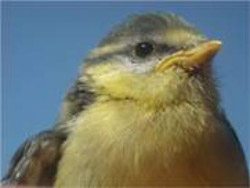Better looking birds have more help at home with their chicks

In choosing a mate both males and females rely on visual cues to determine which potential partner will supply the best genes, best nesting site, best territory, and best parenting skills. Credit: Katharina Mahr<br>
New research published in BioMed Central's open access journal Frontiers in Zoology shows that male blue tits' (Cyanistes caeruleus) parental behavior is determined by female ornamentation (ultraviolet coloration of the crown), as predicted by the differential allocation hypothesis (DAH).
DAH makes the assumption that aesthetic traits indicate quality and arises from the needs of a parent's current need to ensure current reproductive success and the reproductive success of their offspring. Ornamentation and its maintenance is a cost which reduces energy available for reproduction, but without the ornamentation an individual may not be able to secure a mate. Ornamentation also plays a role in competition between males and between females, as well as signaling potential reproductive success.
But reproductive success does not only depend on the best genes and the best nest, it also depends on parenting skills. Researchers from Konrad Lorenz Institute of Ethology, supported by the “Sparkling-Science” Program, investigated the effect of female ornamentation on the chick-rearing behavior of their mates. Both males and female blue tits have feathers on the top of their heads which reflect UV light. After their chicks had hatched, female blue tits were captured and their crowns smeared with either duck preen gland oil containing UV-blocking chemicals or the oil alone.
Although the UV-blocking chemicals did not alter the behavior of the females, their mates made fewer hunting trips to feed their brood. However the males made the same effort to protect their nest and defend their chicks as males with oil-only treated females.
Dr Matteo Griggio, co-author of this study, commented, “This is the first study to show that male blue tit behavior depends on female ornamentation. Even though our experiment was minimally invasive to avoid partners not being able to recognize each other, the behavior of male blue tits in this study matched the DAH. DAH also predicts that less attractive females should increase their parental investment but we found no compensatory female behavior.”
Media Contact
Dr Hilary Glover
Scientific Press Officer, BioMed Central
Tel: +44 (0) 20 3192 2370
Mob: +44 (0) 778 698 1967
Email: hilary.glover@biomedcentral.com
Notes to Editors
1. Female attractiveness affects paternal investment: experimental evidence for male differential allocation in blue tits Katharina Mahr, Matteo Griggio, Michela Granatiero and Herbert Hoi Frontiers in Zoology (in press)
Please name the journal in any story you write. If you are writing for the web, please link to the article. All articles are available free of charge, according to BioMed Central's open access policy.
Article citation and URL available on request on the day of publication.
2. Frontiers in Zoology is an open access, peer-reviewed online journal publishing high quality research articles and reviews on all aspects of animal life.
3. BioMed Central (http://www.biomedcentral.com/) is an STM (Science, Technology and Medicine) publisher which has pioneered the open access publishing model. All peer-reviewed research articles published by BioMed Central are made immediately and freely accessible online, and are licensed to allow redistribution and reuse. BioMed Central is part of Springer Science+Business Media, a leading global publisher in the STM sector.
Media Contact
More Information:
http://www.biomedcentral.comAll latest news from the category: Life Sciences and Chemistry
Articles and reports from the Life Sciences and chemistry area deal with applied and basic research into modern biology, chemistry and human medicine.
Valuable information can be found on a range of life sciences fields including bacteriology, biochemistry, bionics, bioinformatics, biophysics, biotechnology, genetics, geobotany, human biology, marine biology, microbiology, molecular biology, cellular biology, zoology, bioinorganic chemistry, microchemistry and environmental chemistry.
Newest articles

Superradiant atoms could push the boundaries of how precisely time can be measured
Superradiant atoms can help us measure time more precisely than ever. In a new study, researchers from the University of Copenhagen present a new method for measuring the time interval,…

Ion thermoelectric conversion devices for near room temperature
The electrode sheet of the thermoelectric device consists of ionic hydrogel, which is sandwiched between the electrodes to form, and the Prussian blue on the electrode undergoes a redox reaction…

Zap Energy achieves 37-million-degree temperatures in a compact device
New publication reports record electron temperatures for a small-scale, sheared-flow-stabilized Z-pinch fusion device. In the nine decades since humans first produced fusion reactions, only a few fusion technologies have demonstrated…





















